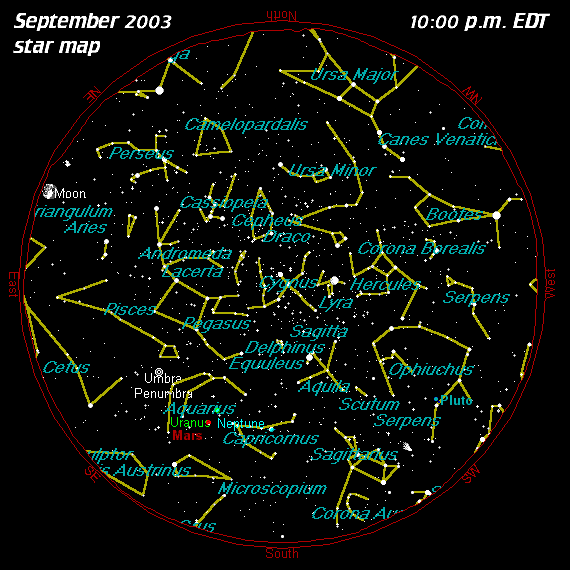



![[Moon Phases]](../moonphases/2003-09-phases.jpg) |
|---|
![[Mars in the East]](9-03-mars.gif) |
|---|
| Mars is now visible low in the east as it is getting dark. It rises about 7 p.m. this week. Diagram by Gary A. Becker... |
![[Mars Watch]](9-03-mars-watch1.jpg) |
|---|
| Above The public gave a warm reception to viewing Mars and the moon through a variety of different telescopes at a celestial open house hosted by the Allentown School District Planetarium at Dieruff High School on Tuesday, September 9. Below: The "stars" of the show, the moon and Mars (right of the moon) are seen from the top of the main parking lot at Dieruff High School near the end of the Mars Watch. G. A. Becker digital photos... |
![[Mars Watch]](9-03-mars-watch2.jpg) |
|---|
![[Mercury in the East]](9-03-mercury.gif) |
|---|
| Use binoculars to help spot Mercury and Regulus low in the east about one hour before sunrise during the week of September 22. Jupiter and the moon should be a no-brainer. Diagram by Gary A. Becker... |
![[Allen Astronomy, Fall 2003]](2003-allen-fall.jpg) |
|---|
|
Above--Allen Astronomy Class, Fall, 2003: Standing, left to right--Melissa Fermin, Olga M. Suarez, Tiffany N. Grant, Krizia Sabastro, Ricky A. Reed, Peter Chomko, and Ryan J. Long. Sitting, left to right--Chris M. Boyle, Eugene C. Clay, Brian L. McCulloch, and Mark A. Kresge. Below--Dieruff Astronomy Class, Fall, 2003: Standing from left to right--Ashley M. Stombaugh, Crystal Specht, Andrea K. Shive, David T. Poliner, Jonathan H. Hamsher, Patrick L. Ojeil, Ronald Nguyen, Orlando M. Layes, Jian Lin. Sitting, second row left to right--Lisibeth Payano, Kaysia Thomas, Thao-Lynn Tran, Joseph P. Perron-Kozar, Jana K. Hoffman, Evan T. Burke. Sitting, Front Row left to right--Colin James Rindock, Sarabeth Brockley, Erin N. Werkheiser, Kyle A. Hoffman, and Juan Vicenty. G. A. Becker digital photos... |
![[Dieruff Astronomy, Fall 2003]](2003-led-fall.jpg) |
|---|
 |
